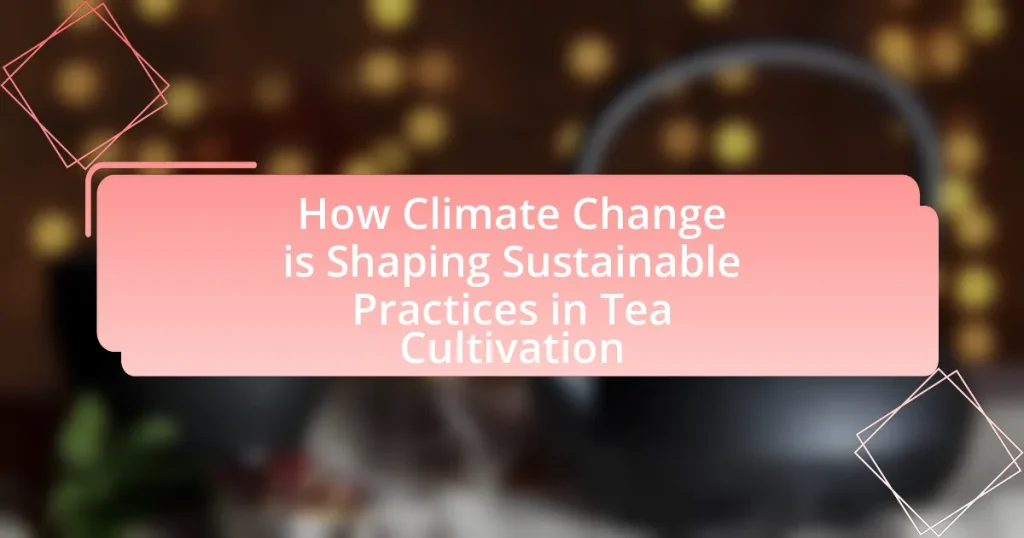The article examines how climate change is influencing sustainable practices in tea cultivation. It highlights the significant impacts of rising temperatures and altered precipitation patterns on tea plant growth, yield, and quality, emphasizing the increased vulnerability to pests and diseases. Key sustainable practices such as agroforestry, organic farming, and precision agriculture are discussed as adaptive strategies for tea farmers to mitigate climate risks. The article also addresses the economic implications of climate change for tea producers and outlines resources available to support the transition to more sustainable methods. Overall, it underscores the necessity for tea farmers to understand and adapt to climate change to ensure long-term viability and productivity in tea cultivation.

How is Climate Change Impacting Tea Cultivation?
Climate change is significantly impacting tea cultivation by altering temperature and precipitation patterns, which affect tea plant growth and yield. Rising temperatures can lead to heat stress in tea plants, reducing their quality and quantity. Additionally, changes in rainfall patterns can result in either drought or excessive moisture, both of which can harm tea crops. For instance, a study published in the journal “Agricultural and Forest Meteorology” found that a 1°C increase in temperature could decrease tea yields by up to 20% in certain regions. Furthermore, climate change can exacerbate pest and disease pressures, further threatening tea production.
What are the primary effects of climate change on tea plants?
Climate change primarily affects tea plants by altering their growth patterns, reducing yields, and increasing susceptibility to pests and diseases. Rising temperatures can lead to accelerated growth, but excessive heat can stress the plants, resulting in lower quality leaves. Additionally, changes in precipitation patterns can cause water stress, impacting the plants’ ability to thrive. Research indicates that a 1°C increase in temperature can reduce tea yields by up to 20% in some regions, highlighting the vulnerability of tea cultivation to climate variability. Furthermore, increased humidity and temperature can promote the spread of pests like the tea mosquito bug, further threatening tea production.
How do temperature changes influence tea growth and quality?
Temperature changes significantly influence tea growth and quality by affecting physiological processes such as photosynthesis, respiration, and nutrient uptake. Optimal temperatures for tea cultivation typically range between 20°C to 30°C; deviations from this range can lead to reduced growth rates and lower leaf quality. For instance, higher temperatures can accelerate leaf maturation, resulting in a decrease in the desirable flavor compounds, while lower temperatures can slow growth and delay harvest times. Research indicates that temperature increases of 1°C to 2°C can lead to a 10% to 20% reduction in yield and quality, as reported in studies by the International Centre for Tropical Agriculture. Thus, temperature fluctuations directly impact both the quantity and quality of tea produced.
What role does altered precipitation play in tea cultivation?
Altered precipitation significantly impacts tea cultivation by affecting water availability, soil moisture, and plant health. Changes in rainfall patterns can lead to either excessive water, causing root rot and disease, or insufficient water, resulting in drought stress that hampers growth and reduces yield. For instance, studies have shown that regions experiencing increased rainfall variability face challenges in maintaining optimal tea quality and quantity, as tea plants require consistent moisture levels for healthy development. Additionally, research indicates that fluctuations in precipitation can disrupt the timing of tea harvesting, further complicating production schedules and economic stability for farmers.
Why is understanding climate change crucial for tea farmers?
Understanding climate change is crucial for tea farmers because it directly impacts tea production, quality, and sustainability. Climate change leads to altered rainfall patterns, increased temperatures, and extreme weather events, which can affect the growth cycles of tea plants and the prevalence of pests and diseases. For instance, research indicates that a 1°C increase in temperature can reduce tea yields by up to 20%. By comprehending these changes, tea farmers can adapt their cultivation practices, select more resilient tea varieties, and implement sustainable farming techniques to mitigate risks and ensure long-term viability.
How can climate change awareness improve farming practices?
Climate change awareness can improve farming practices by enabling farmers to adopt more sustainable and adaptive methods. Increased understanding of climate impacts encourages farmers to implement practices such as crop rotation, soil conservation, and water management, which enhance resilience against climate variability. For instance, research from the Food and Agriculture Organization indicates that sustainable practices can increase yields by up to 20% while reducing greenhouse gas emissions. By integrating climate-smart agriculture techniques, farmers can optimize resource use and improve productivity, ultimately leading to more sustainable tea cultivation in the face of climate change.
What are the economic implications of climate change for tea producers?
Climate change poses significant economic implications for tea producers, primarily through altered weather patterns, which affect crop yields and quality. For instance, rising temperatures and unpredictable rainfall can lead to reduced tea production, as evidenced by a study from the International Centre for Tropical Agriculture, which found that tea yields in regions like Assam could decline by up to 50% by 2050 due to climate variability. Additionally, increased pest and disease prevalence, driven by warmer climates, can further diminish crop quality and increase production costs. Consequently, these factors can lead to higher prices for consumers and reduced income for producers, threatening the livelihoods of millions who depend on tea cultivation.

What Sustainable Practices are Emerging in Tea Cultivation?
Sustainable practices emerging in tea cultivation include agroforestry, organic farming, and integrated pest management. Agroforestry involves planting tea alongside trees, which enhances biodiversity and improves soil health. Organic farming eliminates synthetic fertilizers and pesticides, promoting ecological balance and reducing chemical runoff. Integrated pest management combines biological control methods with minimal chemical use, effectively managing pests while safeguarding the environment. These practices are increasingly adopted as tea producers respond to climate change impacts, aiming to maintain productivity and environmental integrity. For instance, a study published in the Journal of Sustainable Agriculture highlights that agroforestry systems can increase tea yield by up to 30% while improving carbon sequestration.
How are farmers adapting to climate change through sustainable methods?
Farmers are adapting to climate change through sustainable methods by implementing practices such as agroforestry, organic farming, and water conservation techniques. These methods enhance soil health, increase biodiversity, and improve resilience against climate impacts. For instance, agroforestry integrates trees with tea cultivation, which helps in carbon sequestration and provides shade, reducing temperature extremes. Organic farming reduces reliance on chemical fertilizers and pesticides, promoting healthier ecosystems. Additionally, water conservation techniques, such as rainwater harvesting and drip irrigation, optimize water use, crucial in regions facing droughts. These sustainable practices not only mitigate the effects of climate change but also contribute to long-term agricultural productivity and environmental health.
What techniques are being used to conserve water in tea farming?
Techniques used to conserve water in tea farming include drip irrigation, rainwater harvesting, and mulching. Drip irrigation delivers water directly to the plant roots, minimizing evaporation and runoff, which can reduce water usage by up to 50% compared to traditional methods. Rainwater harvesting captures and stores rainwater for irrigation, providing a sustainable water source during dry periods. Mulching helps retain soil moisture and reduces the need for additional watering, as it prevents evaporation and suppresses weed growth. These methods collectively enhance water efficiency in tea cultivation, addressing the challenges posed by climate change.
How does organic farming contribute to sustainability in tea cultivation?
Organic farming enhances sustainability in tea cultivation by promoting biodiversity, reducing chemical inputs, and improving soil health. This method encourages the use of natural fertilizers and pest control, which minimizes environmental pollution and supports ecosystem balance. Research indicates that organic tea farms can increase soil organic matter by 20-30%, leading to better water retention and reduced erosion. Additionally, organic practices often result in higher resilience to climate change impacts, as diverse cropping systems can better withstand extreme weather conditions.
What role does technology play in sustainable tea practices?
Technology plays a crucial role in sustainable tea practices by enhancing efficiency and reducing environmental impact. Precision agriculture technologies, such as drones and soil sensors, enable farmers to monitor crop health and optimize resource use, leading to reduced water consumption and minimized chemical inputs. For instance, a study published in the Journal of Cleaner Production found that using precision irrigation can decrease water usage by up to 30% in tea cultivation. Additionally, data analytics and machine learning can predict pest outbreaks, allowing for targeted interventions that lower pesticide use. These technological advancements not only promote sustainability but also improve the overall quality and yield of tea crops, aligning with the goals of sustainable agriculture in the face of climate change.
How can precision agriculture enhance tea cultivation sustainability?
Precision agriculture enhances tea cultivation sustainability by optimizing resource use and minimizing environmental impact. This approach employs technologies such as soil sensors, satellite imagery, and data analytics to monitor and manage tea crops more effectively. For instance, precision irrigation systems can reduce water usage by delivering the exact amount needed, which is crucial in regions facing water scarcity due to climate change. Additionally, targeted application of fertilizers and pesticides minimizes chemical runoff, protecting local ecosystems. Studies have shown that farms utilizing precision agriculture techniques can achieve up to 30% higher yields while reducing input costs and environmental footprints, thereby promoting long-term sustainability in tea cultivation.
What innovations are being developed to combat climate change in tea farming?
Innovations being developed to combat climate change in tea farming include the adoption of climate-resilient tea varieties, precision agriculture technologies, and agroforestry practices. Climate-resilient tea varieties are bred to withstand extreme weather conditions, such as drought and heavy rainfall, which are becoming more frequent due to climate change. Precision agriculture technologies, such as soil moisture sensors and satellite imagery, enable farmers to optimize water usage and reduce waste, thereby enhancing sustainability. Agroforestry practices integrate tea cultivation with tree planting, which helps sequester carbon and improve biodiversity. These innovations are supported by research from institutions like the International Tea Research Institute, which emphasizes the importance of sustainable practices in mitigating climate impacts on tea production.

What are the Future Trends in Sustainable Tea Cultivation?
Future trends in sustainable tea cultivation include the adoption of agroecological practices, increased use of technology for precision farming, and a focus on biodiversity conservation. Agroecological practices, such as intercropping and organic farming, enhance soil health and reduce chemical inputs, aligning with sustainability goals. Technology, including drones and data analytics, allows farmers to monitor crop health and optimize resource use, leading to more efficient cultivation methods. Additionally, biodiversity conservation efforts, such as preserving native plant species and promoting agroforestry, help mitigate the impacts of climate change on tea production. These trends are supported by research indicating that sustainable practices can improve resilience against climate variability and enhance long-term productivity in tea cultivation.
How will climate change shape the future of tea production?
Climate change will significantly alter tea production by affecting growing conditions, yields, and the geographical distribution of tea cultivation. Rising temperatures and altered precipitation patterns are expected to lead to increased pest and disease pressures, which can reduce crop yields. For instance, studies indicate that a 1°C increase in temperature could decrease tea yields by up to 20% in some regions. Additionally, climate change may shift suitable tea-growing areas, pushing cultivation to higher altitudes or different latitudes, which could disrupt traditional farming practices and local economies. These changes necessitate the adoption of sustainable practices, such as integrated pest management and water conservation techniques, to adapt to the new environmental conditions and maintain production levels.
What are the predicted impacts of climate change on tea varieties?
Climate change is predicted to significantly affect tea varieties by altering their growth conditions, leading to changes in yield, quality, and flavor profiles. Increased temperatures and altered precipitation patterns can stress tea plants, making them more susceptible to pests and diseases, which may reduce overall production. Research indicates that a rise in temperature by 1-2 degrees Celsius could decrease tea yields by up to 20% in some regions, while changes in rainfall patterns could further exacerbate these effects by impacting water availability. Additionally, climate change may shift the geographical suitability for certain tea varieties, forcing growers to adapt by selecting more resilient strains or altering cultivation practices to maintain quality and sustainability.
How can tea producers prepare for future climate scenarios?
Tea producers can prepare for future climate scenarios by adopting resilient agricultural practices and diversifying their crop varieties. Implementing agroforestry systems, which integrate tea cultivation with other crops and trees, can enhance biodiversity and improve soil health, making tea farms more resilient to climate variability. Additionally, utilizing drought-resistant tea varieties can help mitigate the impacts of reduced rainfall, as evidenced by research from the International Tea Research Institute, which highlights the importance of genetic diversity in enhancing resilience. Furthermore, investing in water management techniques, such as rainwater harvesting and drip irrigation, can optimize water use efficiency, crucial for adapting to changing precipitation patterns.
What best practices can tea farmers adopt for sustainability?
Tea farmers can adopt agroecological practices to enhance sustainability. These practices include intercropping, which promotes biodiversity and reduces pest outbreaks, and organic farming techniques that minimize chemical inputs, thereby protecting soil health and water quality. Research indicates that organic tea farming can lead to a 20% increase in soil organic matter, improving soil fertility and resilience against climate change. Additionally, implementing water conservation techniques, such as rainwater harvesting and drip irrigation, can significantly reduce water usage, which is crucial in regions facing water scarcity due to climate change.
How can collaboration among farmers enhance sustainable practices?
Collaboration among farmers enhances sustainable practices by facilitating knowledge sharing, resource pooling, and collective action. When farmers work together, they can exchange best practices for soil management, pest control, and water conservation, leading to improved crop yields and reduced environmental impact. For instance, a study published in the Journal of Sustainable Agriculture found that farmers who participated in cooperative networks adopted more sustainable agricultural techniques, resulting in a 30% increase in overall productivity while minimizing chemical inputs. This collaborative approach not only strengthens individual farm resilience but also contributes to the broader goal of sustainable agriculture in the face of climate change.
What resources are available for tea farmers to implement sustainable methods?
Tea farmers can access various resources to implement sustainable methods, including agricultural extension services, financial support programs, and certification schemes. Agricultural extension services provide technical guidance on sustainable practices such as organic farming, integrated pest management, and soil conservation techniques. Financial support programs, often offered by governments or NGOs, can assist farmers in transitioning to sustainable practices by providing grants or low-interest loans. Certification schemes, such as Rainforest Alliance or Fair Trade, offer frameworks for sustainable farming and can enhance market access and consumer trust. These resources collectively enable tea farmers to adopt environmentally friendly practices while maintaining economic viability.


